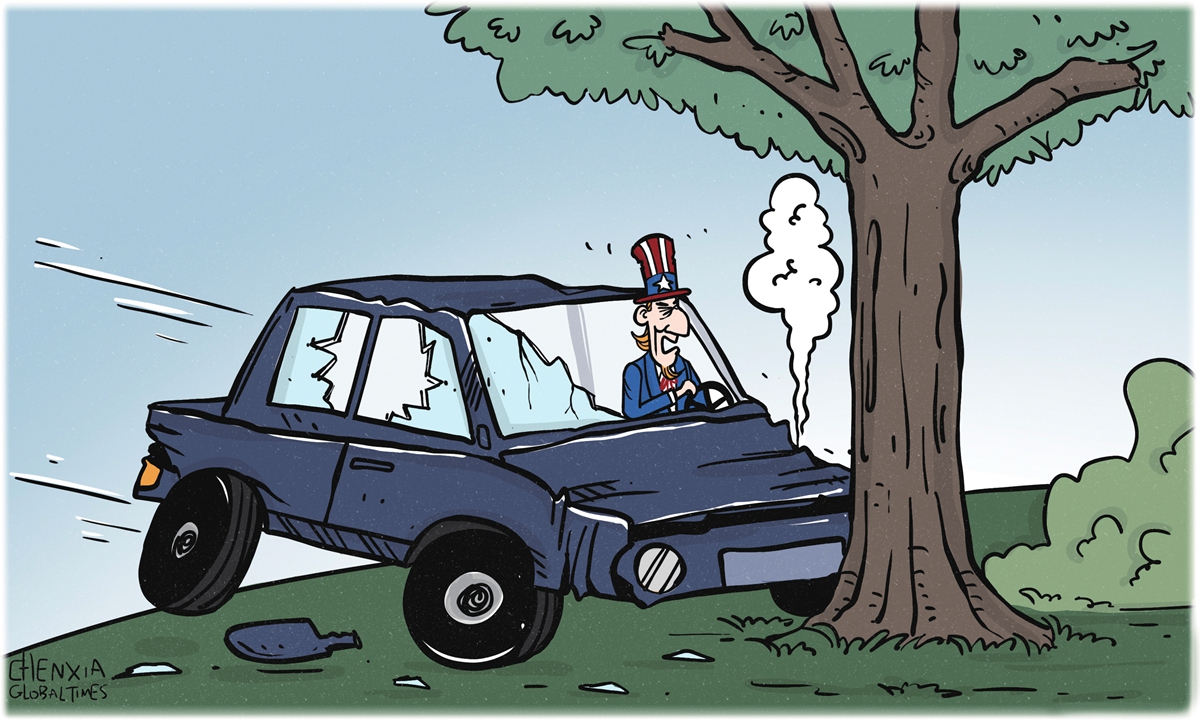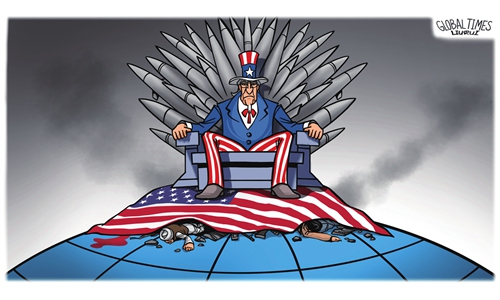
Illustration: Chen Xia/GT
Given the situation in US domestic and foreign policy, rounds and rounds of discussions among academic and public opinion circles on whether the US' self-correction ability has failed and whether the US has declined, have been going on for some time. The fundamental issue behind the questions is how should observers understand today's US?The US is a superpower. Normally, for a major power, as long as there is no domestic chaos, its challenges from the outside are relatively controllable. But the current challenge for the US is that it faces a number of intensifying internal controversies.
To begin with, the US is faced with conflicts among different social classes. This contradiction has always existed, but has been aggravating in recent years. In 2011, Occupy Wall Street, a protest movement against economic inequality and the influence of money in politics broke out. Its slogan was, "We are the 99 percent," referring to income and wealth inequality in the US between the wealthiest 1 percent and the rest of the population. The movement came to an end in November 2011, but the contradiction has continued, leading to rising populism.
The second is political polarization, or growing contradictions between the left and the right. In the past, both Democratic and Republican parties had strong moderate forces. But somehow the moderate forces have been waning over the years. The left-wing forces in the Democratic Party are keen to engage in identity politics and pin labels on others. In the Republican Party, populist right-wing forces have obtained the upper hand. This has made it increasingly harder for both sides to reach any compromise. The US is thus trapped in a vicious circle of "veto politics," and has run out of governance capability.
The third is racial contradictions and tensions between blacks and whites. After the civil rights movement in 1950s and 1960s, the problem has been alleviated over time, but it is rising again today with more complexities, such as growing discrimination against Asians.
Whilst the above-mentioned problems are old issues for the US, there are also new headaches.
The fourth is the contradiction between the real economy and the virtual economy. As internet economy has been growing several times faster than US real economy, divisions and contradictions have emerged among US capitalist groups. This has never happened in the US before. It means cracks are growing amongst US elites and the ruling class.
The fifth is the contradiction between globalism and nativism. People in US coastal areas and capitalist groups support globalization, as they have strong bonds with the outside world and have gained benefits from it. But those living in inland tend to support nativism.
Both old and new problems have made the US more complicated than ever before in modern times. Worse, the US lacks real politicians. There was a time when the US had Abraham Lincoln, Franklin Roosevelt, and other leaders with visions. But there is no one like them nowadays. There are numerous politicians, but they are mostly the puppets of different interests groups. The US once had a system that could correct its errors, but now, people are not sure whether they could still say so.
Whether the US can once again demonstrate its resilience among all the puzzles depends on whether it can confront its problems, pool its resources and utilize strength to promote economic and technological development, slowing down its political infighting and bringing social contradictions under control.
But it seems the US can hardly face up to its problems. The Biden administration has kept blaming the Russia-Ukraine conflict for surging inflation, and blaming China for its domestic employment and broader economic problems. The fundamental logic of Washington is finding a scapegoat for its own failures, forcing others to take the medicine when itself is sick.
Moreover, the US is not as strong as it used to be. Years after the attack on Pearl Harbor during the World War II, the US built a considerable number of aircraft carriers, destroyers and fighter jets. But now, as its virtual economy squeezes its real economy, the strength of the US no longer exists. The US is like an old man, who had his glorious days, but has lost its ability to correct his own errors. Against the backdrop, a simple tumble could be fatal.
Granted, the US is still the superpower. But with all its contradictions, observers need to view the country with a new angle.
The author is a professor at School of International Studies at the Renmin University of China. opinion@globaltimes.com.cn


